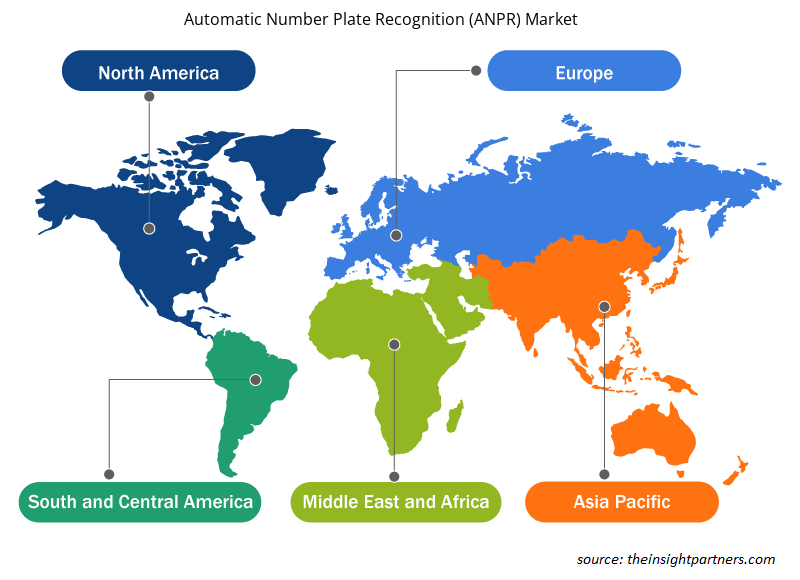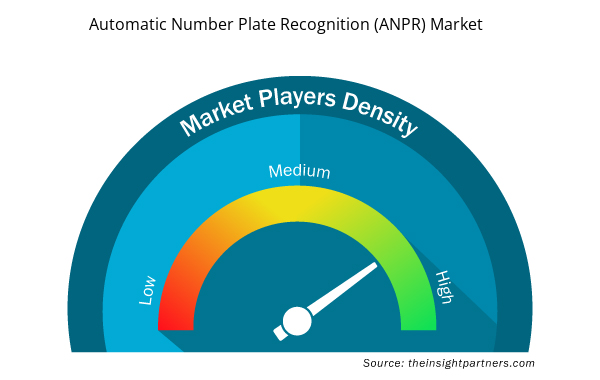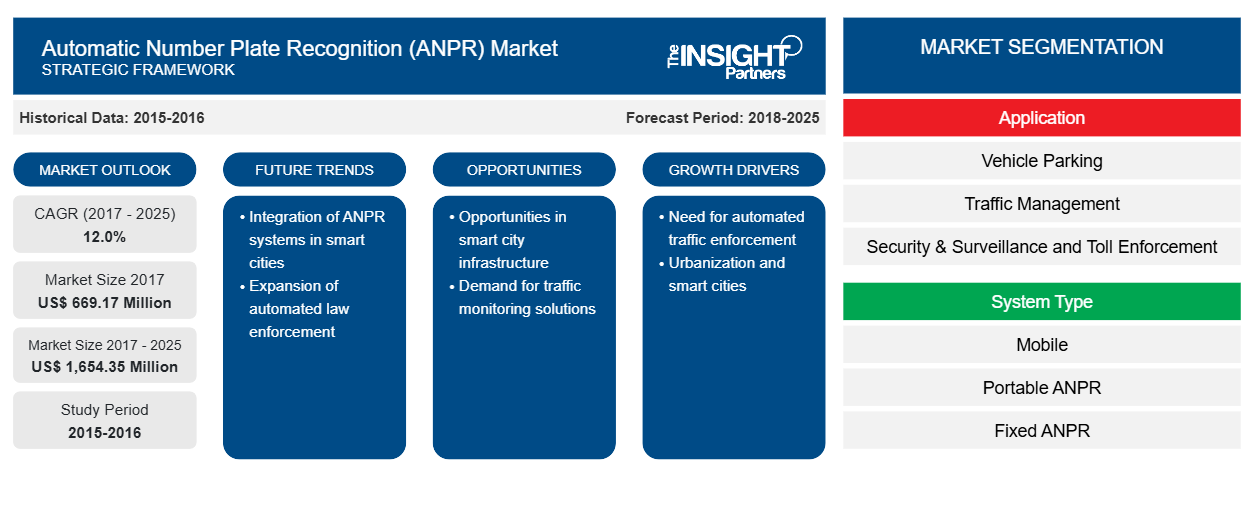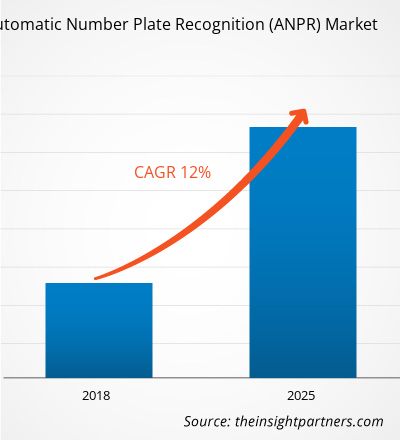Der globale Markt für automatische Nummernschilderkennung soll von 669,17 Millionen US-Dollar im Jahr 2017 auf 1.654,35 Millionen US-Dollar im Jahr 2025 wachsen, was einer durchschnittlichen jährlichen Wachstumsrate (CAGR) von 12,0 % zwischen 2017 und 2025 entspricht.
Der Markt für automatische Kennzeichenerkennung wird in naher Zukunft weltweit voraussichtlich stark wachsen. Zu den wichtigsten Wachstumsfaktoren zählen die zunehmende Akzeptanz des Smart-Parking-Konzepts in Industrie- und Entwicklungsländern sowie der Ausbau der Infrastruktur in Schwellenländern. Die Entwicklung einer gemeinsamen Plattform für den Austausch von Daten aus unterschiedlichen Quellen und technologische Fortschritte sind jedoch einige der zukünftigen Trends des Marktes für automatische Kennzeichenerkennung im Prognosezeitraum.
Markteinblicke
Das Segment der Sicherheits- und Überwachungsanwendungen gewinnt weltweit an Bedeutung
Bei der Einführung des Konzepts der automatischen Kennzeichenerkennung stand vor allem die Überwachung von Fahrzeugen im Mittelpunkt. In vielen Ländern der Welt kommt es zu unterschiedlichen Arten von Kriminalität, und die Zahl der Fahrzeugkriminalität nimmt zu, da die Flucht mit Fahrzeugen einfacher ist. Die Eindämmung solcher Verbrechen ist notwendig geworden, und daher hat sich der Einsatz von in die Sicherheitssysteme integrierten ANPR-Systemen als äußerst nützlich erwiesen. Außerdem haben Regierungen auf der ganzen Welt verschiedene Vorschriften zu Geschwindigkeitsbegrenzungen und Autobesitz erlassen, um Verkehrsstaus und Luftverschmutzung, insbesondere in Ballungsgebieten, in den Griff zu bekommen. Die Überwachung dieser Vorschriften wird durch den Einsatz von ANPR-Kameras gut unterstützt, und daher wird ihr Markt immer stärker angenommen.
Passen Sie diesen Bericht Ihren Anforderungen an
Sie erhalten kostenlos individuelle Anpassungen an jedem Bericht, einschließlich Teilen dieses Berichts oder einer Analyse auf Länderebene, eines Excel-Datenpakets sowie tolle Angebote und Rabatte für Start-ups und Universitäten.
- Holen Sie sich die wichtigsten Markttrends aus diesem Bericht.Dieses KOSTENLOSE Beispiel umfasst eine Datenanalyse von Markttrends bis hin zu Schätzungen und Prognosen.
Markt für automatische Nummernschilderkennung dürfte in der Region Asien-Pazifik florieren
Der asiatisch-pazifische Raum umfasst mehrere Entwicklungsländer wie China, Japan, Südkorea und Indien, deren Bevölkerung stark wächst, was wiederum zu einer hohen Nachfrage nach besseren öffentlichen Einrichtungen in der Region führt. Der Markt für automatische Nummernschilderkennung im asiatisch-pazifischen Raum verzeichnet aufgrund der zunehmenden Nutzung vernetzter Geräte und der Industrialisierung ein deutliches Wachstum. Australien ist führend bei der Einführung von Systemen zur automatischen Nummernschilderkennung, während China und Südkorea in Bezug auf den Umsatz im asiatisch-pazifischen Raum den zweitgrößten Anteil am Markt für automatische Nummernschilderkennung haben, wobei in der ANPR- und ITS-Branche viele intelligente Initiativen ergriffen werden. Diese Faktoren werden voraussichtlich die Nachfrage nach automatischer Nummernschilderkennung im asiatisch-pazifischen Raum weiter ankurbeln.APAC region with plenty of smart initiatives being taken in the ANPR & ITS industry. These factors are anticipated to further propel the demand for automatic number plate recognition in APAC region.
Die Entwicklung neuer Produkte erwies sich als die am häufigsten angewandte Strategie auf dem globalen Markt für automatische Kennzeichenerkennung. Nachfolgend sind einige der jüngsten Strategien einiger Akteure auf dem Markt für automatische Kennzeichenerkennung aufgeführt:
2017: Das Unternehmen 3M stellte eine „revolutionäre“ ANPR-Kamera vor
. 2017: Siemens schloss die Einführung eines permanenten Systems zur Überwachung der Durchschnittsgeschwindigkeit in ganz London ab.
2017: Q-Free ist zusammen mit dem Queensland Department of Transport and Main Roads (TMR) an seinem dritten australischen Cooperative ITS (C-ITS)-Projekt beteiligt.
2017: Die Intrada Automatic Licence Plate Recognition (ALPR)-Technologie von Q-Free ist für den Einsatz mit Software des US-Unternehmens C2P zertifiziert.
Regionale Einblicke in den Markt für automatische Nummernschilderkennung (ANPR)
Die regionalen Trends und Faktoren, die den Markt für automatische Nummernschilderkennung (ANPR) während des gesamten Prognosezeitraums beeinflussen, wurden von den Analysten von Insight Partners ausführlich erläutert. In diesem Abschnitt werden auch Marktsegmente und Geografie für automatische Nummernschilderkennung (ANPR) in Nordamerika, Europa, im asiatisch-pazifischen Raum, im Nahen Osten und Afrika sowie in Süd- und Mittelamerika erörtert.

- Erhalten Sie regionalspezifische Daten zum Markt für automatische Nummernschilderkennung (ANPR)
Umfang des Marktberichts zur automatischen Nummernschilderkennung (ANPR)
| Berichtsattribut | Details |
|---|---|
| Marktgröße im Jahr 2017 | 669,17 Millionen US-Dollar |
| Marktgröße bis 2025 | 1.654,35 Millionen US-Dollar |
| Globale CAGR (2017 - 2025) | 12,0 % |
| Historische Daten | 2015–2016 |
| Prognosezeitraum | 2018–2025 |
| Abgedeckte Segmente | Nach Anwendung
|
| Abgedeckte Regionen und Länder | Nordamerika
|
| Marktführer und wichtige Unternehmensprofile |
|
Marktteilnehmerdichte: Der Einfluss auf die Geschäftsdynamik
Der Markt für automatische Nummernschilderkennung (ANPR) wächst rasant, angetrieben durch die steigende Nachfrage der Endnutzer aufgrund von Faktoren wie sich entwickelnden Verbraucherpräferenzen, technologischen Fortschritten und einem größeren Bewusstsein für die Vorteile des Produkts. Mit steigender Nachfrage erweitern Unternehmen ihr Angebot, entwickeln Innovationen, um die Bedürfnisse der Verbraucher zu erfüllen, und nutzen neue Trends, was das Marktwachstum weiter ankurbelt.
Die Marktteilnehmerdichte bezieht sich auf die Verteilung der Firmen oder Unternehmen, die in einem bestimmten Markt oder einer bestimmten Branche tätig sind. Sie gibt an, wie viele Wettbewerber (Marktteilnehmer) in einem bestimmten Marktraum im Verhältnis zu seiner Größe oder seinem gesamten Marktwert präsent sind.
Die wichtigsten Unternehmen auf dem Markt für automatische Nummernschilderkennung (ANPR) sind:
- 3m Unternehmen
- ARH, Inc.
- COBAN Technologies, Inc.
- Digital Recognition Systems, Ltd.
- Genetec, Inc.
Haftungsausschluss : Die oben aufgeführten Unternehmen sind nicht in einer bestimmten Reihenfolge aufgeführt.

- Überblick über die wichtigsten Akteure auf dem Markt für automatische Nummernschilderkennung (ANPR)
Globale automatische Nummernschilderkennung – Marktsegmentierung
Nach Anwendung
- Parken von Fahrzeugen
- Verkehrsmanagement
- Sicherheit und Überwachung
- Mautkontrolle
Nach Systemtyp
- Mobile
- Tragbare ANPR
- Feste ANPR
Nach Endbenutzer
- Regierung
- Kommerziell
Nach Geografie
Nordamerika
- UNS
- Kanada
- Mexiko
Europa
- Frankreich
- Deutschland
- Italien
- Vereinigtes Königreich
Asien-Pazifik (APAC)
- Japan
- China
- Indien
- Restlicher Asien-Pazifik-Raum
Naher Osten und Afrika (MEA)
- Südafrika
- Vereinigte Arabische Emirate
Südamerika (SAM)
- Brasilien
Firmenprofile
- 3m Unternehmen
- ARH, Inc.
- COBAN Technologies, Inc.
- Digital Recognition Systems, Ltd.
- Genetec, Inc.
- Jenoptik AG
- Q-freies ASA
- Siemens AG
- Tattile SRL
- Wachsame Lösungen
- Historische Analyse (2 Jahre), Basisjahr, Prognose (7 Jahre) mit CAGR
- PEST- und SWOT-Analyse
- Marktgröße Wert/Volumen – Global, Regional, Land
- Branche und Wettbewerbsumfeld
- Excel-Datensatz



Report Coverage
Revenue forecast, Company Analysis, Industry landscape, Growth factors, and Trends

Segment Covered
This text is related
to segments covered.

Regional Scope
North America, Europe, Asia Pacific, Middle East & Africa, South & Central America

Country Scope
This text is related
to country scope.
Trends and growth analysis reports related to Electronics and Semiconductor : READ MORE..
The List of Companies
1. 3m Company
2. ARH, Inc.
3. COBAN Technologies, Inc.
4. Digital Recognition Systems, Ltd.
5. Genetec, Inc.
6. Jenoptik AG
7. Q-Free ASA
8. Siemens AG
9. Tattile S.R.L
10. Vigilant Solutions
The Insight Partners performs research in 4 major stages: Data Collection & Secondary Research, Primary Research, Data Analysis and Data Triangulation & Final Review.
- Data Collection and Secondary Research:
As a market research and consulting firm operating from a decade, we have published and advised several client across the globe. First step for any study will start with an assessment of currently available data and insights from existing reports. Further, historical and current market information is collected from Investor Presentations, Annual Reports, SEC Filings, etc., and other information related to company’s performance and market positioning are gathered from Paid Databases (Factiva, Hoovers, and Reuters) and various other publications available in public domain.
Several associations trade associates, technical forums, institutes, societies and organization are accessed to gain technical as well as market related insights through their publications such as research papers, blogs and press releases related to the studies are referred to get cues about the market. Further, white papers, journals, magazines, and other news articles published in last 3 years are scrutinized and analyzed to understand the current market trends.
- Primary Research:
The primarily interview analysis comprise of data obtained from industry participants interview and answers to survey questions gathered by in-house primary team.
For primary research, interviews are conducted with industry experts/CEOs/Marketing Managers/VPs/Subject Matter Experts from both demand and supply side to get a 360-degree view of the market. The primary team conducts several interviews based on the complexity of the markets to understand the various market trends and dynamics which makes research more credible and precise.
A typical research interview fulfils the following functions:
- Provides first-hand information on the market size, market trends, growth trends, competitive landscape, and outlook
- Validates and strengthens in-house secondary research findings
- Develops the analysis team’s expertise and market understanding
Primary research involves email interactions and telephone interviews for each market, category, segment, and sub-segment across geographies. The participants who typically take part in such a process include, but are not limited to:
- Industry participants: VPs, business development managers, market intelligence managers and national sales managers
- Outside experts: Valuation experts, research analysts and key opinion leaders specializing in the electronics and semiconductor industry.
Below is the breakup of our primary respondents by company, designation, and region:

Once we receive the confirmation from primary research sources or primary respondents, we finalize the base year market estimation and forecast the data as per the macroeconomic and microeconomic factors assessed during data collection.
- Data Analysis:
Once data is validated through both secondary as well as primary respondents, we finalize the market estimations by hypothesis formulation and factor analysis at regional and country level.
- Macro-Economic Factor Analysis:
We analyse macroeconomic indicators such the gross domestic product (GDP), increase in the demand for goods and services across industries, technological advancement, regional economic growth, governmental policies, the influence of COVID-19, PEST analysis, and other aspects. This analysis aids in setting benchmarks for various nations/regions and approximating market splits. Additionally, the general trend of the aforementioned components aid in determining the market's development possibilities.
- Country Level Data:
Various factors that are especially aligned to the country are taken into account to determine the market size for a certain area and country, including the presence of vendors, such as headquarters and offices, the country's GDP, demand patterns, and industry growth. To comprehend the market dynamics for the nation, a number of growth variables, inhibitors, application areas, and current market trends are researched. The aforementioned elements aid in determining the country's overall market's growth potential.
- Company Profile:
The “Table of Contents” is formulated by listing and analyzing more than 25 - 30 companies operating in the market ecosystem across geographies. However, we profile only 10 companies as a standard practice in our syndicate reports. These 10 companies comprise leading, emerging, and regional players. Nonetheless, our analysis is not restricted to the 10 listed companies, we also analyze other companies present in the market to develop a holistic view and understand the prevailing trends. The “Company Profiles” section in the report covers key facts, business description, products & services, financial information, SWOT analysis, and key developments. The financial information presented is extracted from the annual reports and official documents of the publicly listed companies. Upon collecting the information for the sections of respective companies, we verify them via various primary sources and then compile the data in respective company profiles. The company level information helps us in deriving the base number as well as in forecasting the market size.
- Developing Base Number:
Aggregation of sales statistics (2020-2022) and macro-economic factor, and other secondary and primary research insights are utilized to arrive at base number and related market shares for 2022. The data gaps are identified in this step and relevant market data is analyzed, collected from paid primary interviews or databases. On finalizing the base year market size, forecasts are developed on the basis of macro-economic, industry and market growth factors and company level analysis.
- Data Triangulation and Final Review:
The market findings and base year market size calculations are validated from supply as well as demand side. Demand side validations are based on macro-economic factor analysis and benchmarks for respective regions and countries. In case of supply side validations, revenues of major companies are estimated (in case not available) based on industry benchmark, approximate number of employees, product portfolio, and primary interviews revenues are gathered. Further revenue from target product/service segment is assessed to avoid overshooting of market statistics. In case of heavy deviations between supply and demand side values, all thes steps are repeated to achieve synchronization.
We follow an iterative model, wherein we share our research findings with Subject Matter Experts (SME’s) and Key Opinion Leaders (KOLs) until consensus view of the market is not formulated – this model negates any drastic deviation in the opinions of experts. Only validated and universally acceptable research findings are quoted in our reports.
We have important check points that we use to validate our research findings – which we call – data triangulation, where we validate the information, we generate from secondary sources with primary interviews and then we re-validate with our internal data bases and Subject matter experts. This comprehensive model enables us to deliver high quality, reliable data in shortest possible time.


 Holen Sie sich ein kostenloses Muster für diesen Bericht
Holen Sie sich ein kostenloses Muster für diesen Bericht